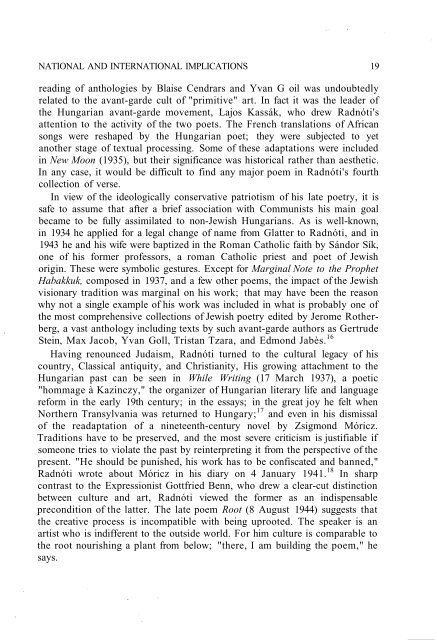HUNGARIAN STUDIES 11. No. 1. Nemzetközi Magyar ... - EPA
HUNGARIAN STUDIES 11. No. 1. Nemzetközi Magyar ... - EPA
HUNGARIAN STUDIES 11. No. 1. Nemzetközi Magyar ... - EPA
- No tags were found...
Create successful ePaper yourself
Turn your PDF publications into a flip-book with our unique Google optimized e-Paper software.
NATIONAL AND INTERNATIONAL IMPLICATIONS 19reading of anthologies by Blaise Cendrars and Yvan G oil was undoubtedlyrelated to the avant-garde cult of "primitive" art. In fact it was the leader ofthe Hungarian avant-garde movement, Lajos Kassák, who drew Radnóti'sattention to the activity of the two poets. The French translations of Africansongs were reshaped by the Hungarian poet; they were subjected to yetanother stage of textual processing. Some of these adaptations were includedin New Moon (1935), but their significance was historical rather than aesthetic.In any case, it would be difficult to find any major poem in Radnóti's fourthcollection of verse.In view of the ideologically conservative patriotism of his late poetry, it issafe to assume that after a brief association with Communists his main goalbecame to be fully assimilated to non-Jewish Hungarians. As is well-known,in 1934 he applied for a legal change of name from Glatter to Radnóti, and in1943 he and his wife were baptized in the Roman Catholic faith by Sándor Sík,one of his former professors, a roman Catholic priest and poet of Jewishorigin. These were symbolic gestures. Except for Marginal <strong>No</strong>te to the ProphetHabakkuk, composed in 1937, and a few other poems, the impact of the Jewishvisionary tradition was marginal on his work; that may have been the reasonwhy not a single example of his work was included in what is probably one ofthe most comprehensive collections of Jewish poetry edited by Jerome Rotherberg,a vast anthology including texts by such avant-garde authors as GertrudeStein, Max Jacob, Yvan Goll, Tristan Tzara, and Edmond Jabès. 16Having renounced Judaism, Radnóti turned to the cultural legacy of hiscountry, Classical antiquity, and Christianity, His growing attachment to theHungarian past can be seen in While Writing (17 March 1937), a poetic"hommage à Kazinczy," the organizer of Hungarian literary life and languagereform in the early 19th century; in the essays; in the great joy he felt when<strong>No</strong>rthern Transylvania was returned to Hungary; 17 and even in his dismissalof the readaptation of a nineteenth-century novel by Zsigmond Móricz.Traditions have to be preserved, and the most severe criticism is justifiable ifsomeone tries to violate the past by reinterpreting it from the perspective of thepresent. "He should be punished, his work has to be confiscated and banned,"Radnóti wrote about Móricz in his diary on 4 January 194<strong>1.</strong> 18 In sharpcontrast to the Expressionist Gottfried Benn, who drew a clear-cut distinctionbetween culture and art, Radnóti viewed the former as an indispensableprecondition of the latter. The late poem Root (8 August 1944) suggests thatthe creative process is incompatible with being uprooted. The speaker is anartist who is indifferent to the outside world. For him culture is comparable tothe root nourishing a plant from below; "there, I am building the poem," hesays.
















